Improving your ability to catch is an underrated part of being a great player.
December 18, 2018 by Charlie Eisenhood in Opinion with 0 comments
Tuesday Tips is presented by Spin Ultimate; all opinions are those of the author. Please support the brands that make Ultiworld possible and shop at Spin Ultimate!
One of the great things about ultimate is the wide variety of skills required to be successful in the sport. You have to develop field sense, speed, endurance, timing, and explosiveness. You have to learn offensive and defensive schemes. But the bedrock fundamentals are simple: throwing and catching.
Many thousands of words have been written about improving your throws, but you won’t find a whole lot out there about catching. There’s good reason for that. Throwing is hard. Becoming a great thrower takes years of work. Catching the disc is comparatively easy, but it doesn’t mean you should overlook developing your abilities as a receiver.
Simply put, you really shouldn’t be dropping the disc. Ever. Don’t be tempted to blame a drop on an errant throw from your handler. If you have the opportunity to get a hand on the disc, you should be catching it.
So let’s talk about the ways to develop great hands and learn to reel in everything.
1. Get Comfortable With Different Styles
There is not a single correct way to catch the disc. Different situations call for different hand positions. Let’s take a look at a few.
The Pancake (Or Clap) Catch
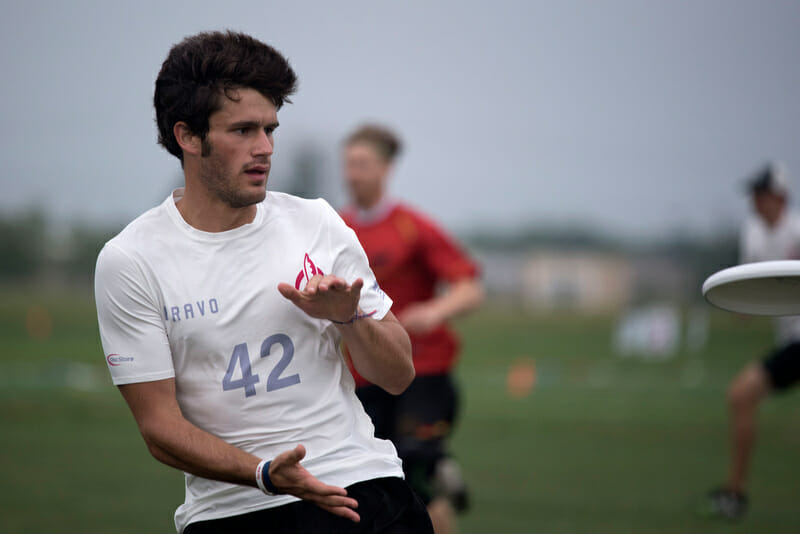
Ben Lohre here is setting up to make a pancake catch. This is your basic ‘one hand on top, one hand on bottom’ catch. If possible, this should be the catching style that you opt for. It maximizes the security of the catch and allows for a bigger margin for error. If the disc pops up or drops slightly (common in windy conditions), you’ll still have a good chance of making the catch. Which hand on top? I think you just want to go with what feels comfortable. Some people like their throwing hand on top. Others like it underneath. You’ll just know. It’s like when you interlace your fingers and you just know which thumb should be on top.
You’ll often see players opting for a clap catch even when they are jumping. It’s simply the best way to catch if you have the option.
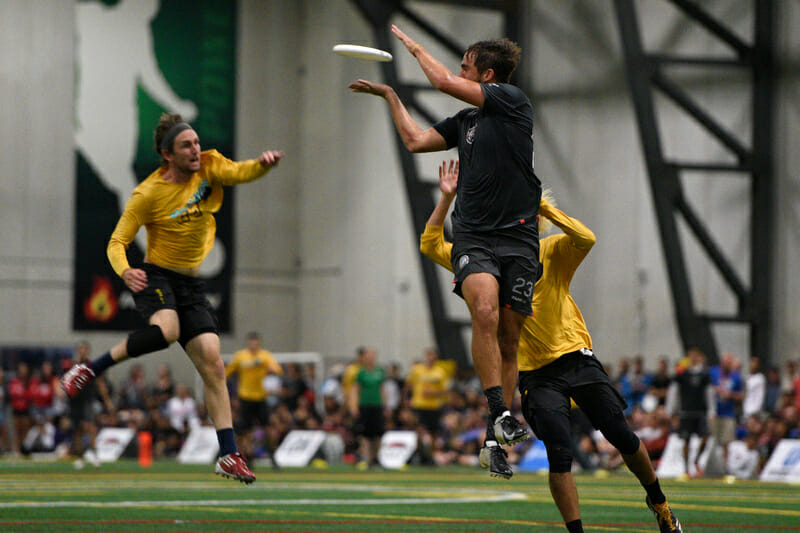
However, this won’t always work. If a disc is coming in high, low, or wide, or you are under pressure, you may be forced to switch to a claw catch or a one-handed catch.
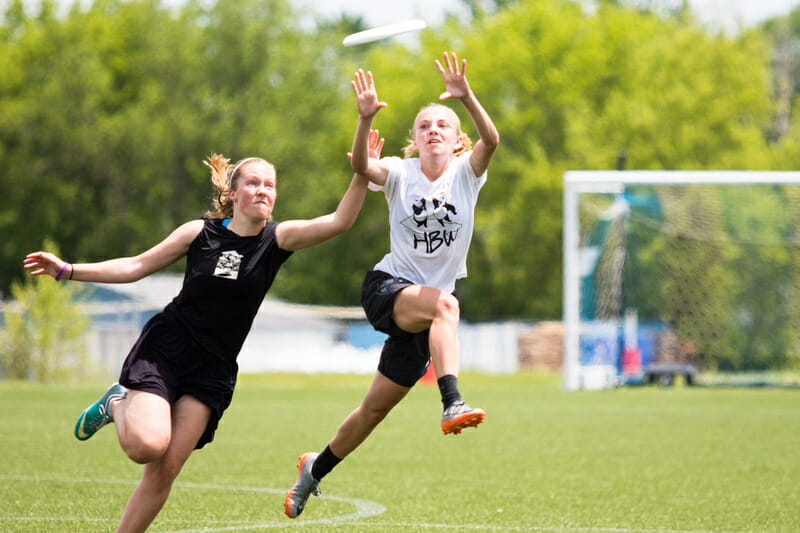
Typically, when the disc is coming at head level or higher (or knee level or lower), you’ll need to switch to a claw catch, like Ella Juengst is about to make above. This is more natural, especially when you’re running. Claw catching also allows you to catch the disc at the maximum distance away from your body, which can be really important when a defender is thinking about trying to run through or layout for a block. Under cutters, especially, must learn to make this catch, and they need to learn how to make it running full speed directly at the disc.
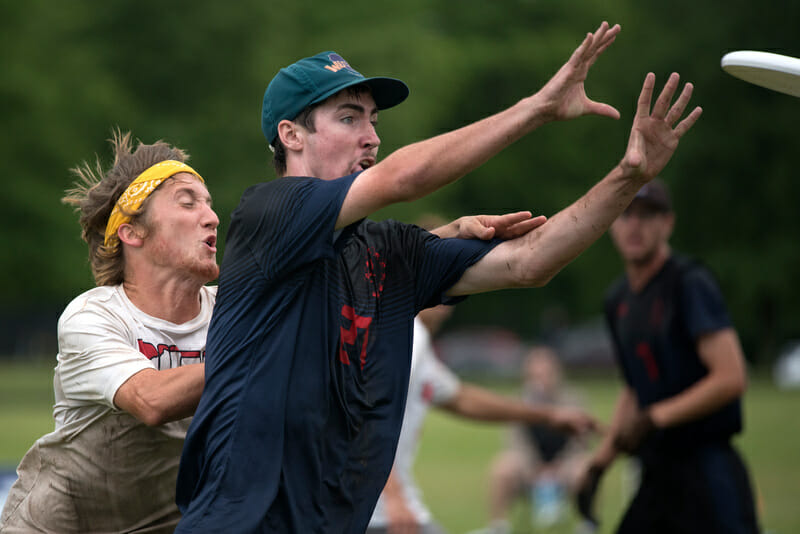
This is a skill that can be developed like any other. You can practice making claw catches both in throwing sessions and in drills.
Note that when the disc is coming in low, you’ll want to switch to a ‘thumbs on top’ claw catch.
The One-Handed Catch
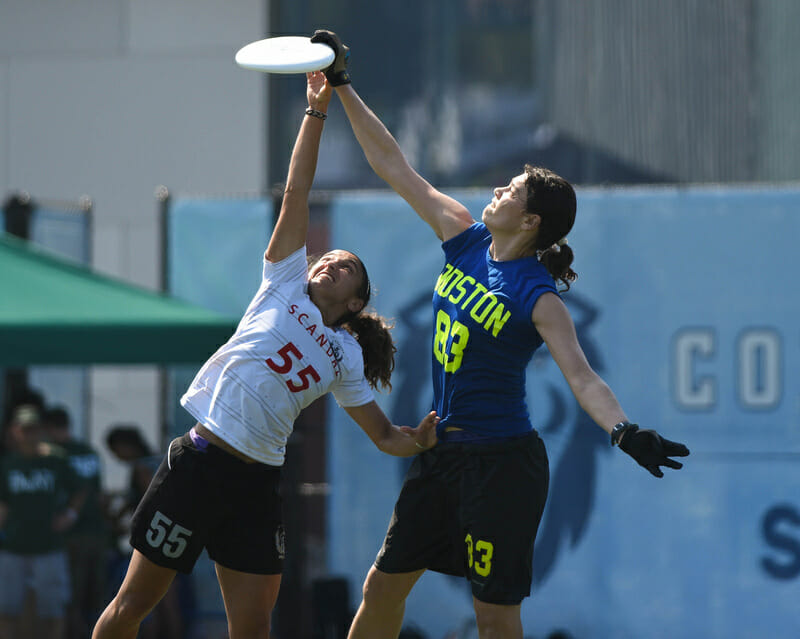
When a disc is coming in high over your head or wide left or right, you will often need to switch to a single hand for the catch. This is the least secure option, but it also allows for the greatest range of catching. You can generally get a better jump and a couple more inches of reach by going up with one hand. If a disc is coming in wide, you often won’t have time to adjust to clap catch, so you have to work on your ability to reach out and stab it with one hand.
It is absolutely essential that you practice single hand catching with your non-dominant hand. You should be opting for the most advantageous hand, not reaching across your body with your throwing hand. If you aren’t comfortable with your off hand, spend throwing drills only catching with it. Again, this is a skill that you can develop with practice. Getting to the point where you naturally choose the correct hand is key.
2. Work On Challenging Catches
All of the above catching styles can be practiced at various levels of intensity. Brummie has a good list of drills to try. You should be learning to catch in a static position, at a jogging pace, at a sprint pace, above your head, at your ankles, and everywhere in between.
One drill I like is to do partner throwing, but waiting until the last possible moment to react and catch the disc one-handed as it gets to you. The later you move, the better. This really helps you improve your ability to adjust to a weird throw or nab something that your handler throws two feet behind you.
If you’re creative, you can find all kinds of ways to work on challenging catches. Some ideas:
- Play Guts
- Play Flutter Guts
- Spend an entire practice only catching with your non-dominant hand
- Spend a throwing session only using a single catching style
- Run ladders where you have to make a high speed claw catch every time you return to the baseline.
- Have a disc in your hands constantly at school or work. Learn to flip it around your thumb and spin it on your finger.
- Layout drills
3. No Drops Allowed

Do not be complacent. You should not be dropping the disc. Of course, drops are going to happen sometimes, but, especially at practice, you should force yourself to do a set number of perfect throws and catches with a partner for every time you drop it.
Having great hands is like shooting free throws. You should be automatic.
4. Warm Up Your Hands

Before games, it’s essentially to warm up your catches just like you warm up your throws, especially if the weather is in any way challenging (cold, hot, windy). Again, work on different types of catches and physically warm up your hands.
One thing I like to do which is admittedly weird but totally works: take a disc and beat my hands up with it. Smacking the front and back of my hands with the disc from various angles helps to get blood flowing and make my hands feel limber. This is particularly important when it’s cold.
You don’t have to go to this extreme, but it is important to make sure that you’re ready to be a high percentage receiver.
5. Watch The Disc

In tennis, you’ve got to watch the ball. In golf, you’ve got to watch the ball. In ultimate, you’ve got to watch the disc.
When you make a catch, no matter whether it is easy or challenging, you need to watch the disc all the way into your hands and complete the catch. Only then can you start to think about the throw or your pivot.
The number one preventable cause of drops is looking away or thinking about the continuation throw before actually securing a completion. I can’t even count the number of times that I’ve watch a wide open upline cut transform into a turnover because the cutter was thinking about the upcoming huck they were planning to throw and dropped the disc.
It’s worth noting that it can be good practice to work on catching discs using only peripheral vision, particularly on throws away from your body. This improves your ability to make grabs on plays where you don’t have the ability to turn and watch the disc into your hand, where you have to rely more on kinesthetic sense and instinct. Practicing ‘freestyle’ catching (between the legs, behind the back) can be good for developing this.
But, in any situation that you can, watch the disc, work to fight the urge to close your eyes on high speed plays, and you’ll make the catch.
***
If you work on the points above, you can become a player with great hands. Like most skills in ultimate, catching can be improved with focused practice. So put yourself in lots of different situations, practice making high degree of difficulty catches in practice, and become your team’s most reliable receiver.